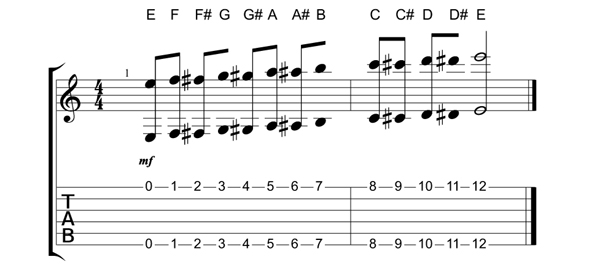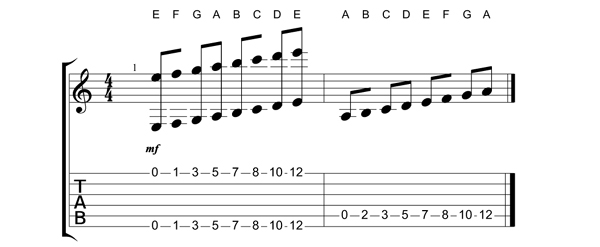It seems that there are a lot of experienced guitarists who do not know the notes across the entire fretboard. They may argue that they just “feel” what they play, which is all well and good, but what happens when they’re improvising in a key that has several sharps or flats, or to a jazz progression with 50 whacked-out chords? They get stumped quick. Unless you’re a musical genius (I’ve only met one), you’d do well to learn to speak the language. Learning the notes on the guitar will also help your understanding of the relationships between chords and scales, and make it easier to communicate with other musicians.
To begin, we need to know the notes of the Chromatic scale. The Chromatic scale consists of 12 notes that divide an octave into 12 parts.
These notes are: A, A#, B, C, C#, D, D#, E, F, F#, G, G#.
After G# the scale starts over again on the note A, but in a new octave. For simplicity I am using only sharps (#), but these can also be referred to as flats (♭). For example, A# and B♭ sound identical, and could go by either name depending on what key you’re in. It’s important to memorize that there is a sharp/flat between every note except for B to C and E to F.
The trick to learning the notes on the fretboard is to take the non-sharped (natural) notes (A, B, C, D, E, F, G) and learn where they fall along each string. Start out by simultaneously learning both the high and low E strings (first and sixth strings respectively) up to the 12th fret, as the note names are identical along each string. Memorize the eight “natural” notes of the octave up to the 12th fret to the point where you can jump all over and not think twice. Learn the natural notes on the other strings by applying the chromatic scale starting with the note name of the open string. The names of the open strings from thinnest to thick are: E, B, G, D, A, E. Learn a string per day or two, and soon you’ll have the natural notes on all six strings down pat.
Two pretty neat things happen when you accomplish this. First, you can congratulate yourself on learning the keys of both C major and A minor (and associated modes), both of which share the same notes and have no “accidentals” (sharps & flats). Second, is the ability to play in another key simply by sharping or flatting the appropriate notes. It’s easy to find a G# if you know where all your Gs are!
Looking to improve your guitar skills? Call Chambers Guitars for lessons at (615) 898-0055.














